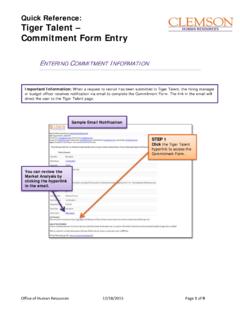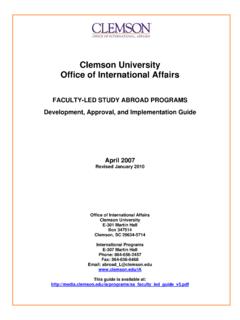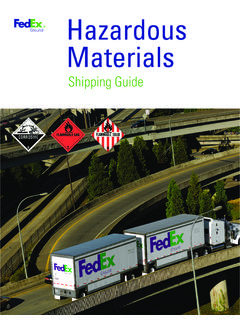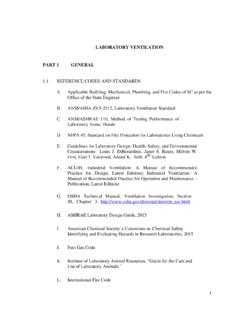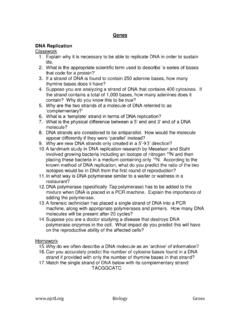Transcription of Honors Biology Ninth Grade Pendleton High School
1 Unit Plan DNA, RNA, and Protein Synthesis Honors Biology Ninth Grade Pendleton high School TABLE OF CONTENTS Unit Overview Unit Topic Grade Level and Student Culture Class Structure Rationale Objectives Content References and Resources Daily Lesson Plans Unit Analysis Interpretations and Decisions Reflection Appendix Pretest Notes Power Points Student Notes Sheets Worksheets and Lab Handouts Quizzes Unit Test and Answer Key UNIT OVERVIEW UNIT TOPIC: DNA, RNA, and Protein Synthesis Standard B-4, Indicators , , , Grade LEVEL AND STUDENT CULTURE: 9th Grade Honors Biology students, FreshmanAcademy CLASS STRUCTURE: three 45-minute periods (Monday/Tuesday/Friday) and one 90-minute period (Wednesday/Thursday) RATIONALE: The cell is an amazingly fine-tuned machine, working nonstop to maintain homeostasis of organisms. The most crucial of all maintenance systems of the cell s processes is protein synthesis. Without proteins, life would not exist as we know it.
2 This unit provides that understanding of the basic cellular processes that unify all living organisms and provides a basis of understanding of molecular heredity. It is essential that students understand how their own body functions and provides a means for the passing of genetic material to offspring. This unit also provides an opportunity to reinforce student understanding of the nature of scientific discovery, that advances in science requires contributions from many people over long period of time. The details of protein synthesis are integral to many research and discovery endeavors of the twenty-first century. Students should be taught not only content knowledge but how to be a global citizen. This unit provides students with the tools to be a cognizant and knowledgeable citizen, capable of understanding advances in modern sciences. A basic understanding of the genetic code of organisms is also important for visualizing evolution across generations.
3 As students learn about evolution, they will be able to apply their knowledge of DNA as the genetic code to the differences seen in populations over time. OBJECTIVES: The student should understand the molecular basis of heredity, specifically the role of DNA as the genetic material of organisms and the process of protein synthesis, specifically the processes of transcription and translation. Students should be able to 1) understand that DNA has a transient yet stable nature science is about change 2) describe the process of protein synthesis and 3) identify the products of replication, transcription and can be broken down further into: The student should be able to: 1. Describe the discoveries that led to the acceptance of DNA as the genetic material2. Describe the characteristics of DNA and the process of replication3. Explain the flow of information from DNA to RNA to proteins4. Illustrate/identify illustrations of the processes of replication, transcription, andtranslation5.
4 Sequence the steps of protein synthesis6. Explain the significance of protein synthesisThrough these objectives the student should expand his learning on the following key concepts and enduring ideas of science: 1. Tentative and every-changing nature of science and discovery2. Unifying nature of human processes, specifically cellular processes3. Connections between scientific knowledge and real-world applicationsThe student should be prepared for standardized assessment on the following: Standard B-4:The student will demonstrate an understanding of the molecular basis of heredity. Compare DNA and RNA in terms of structure, nucleotides, and base pairs. Summarize the relationship among DNA, genes, and chromosomes. Explain how DNA functions as the code of life and the blueprint for proteins. Summarize the basic processes involved in protein synthesis (including transcription and translation). CONTENT: The content of this unit is broken down into three sections: DNA, Chromosomes and DNA Replication, RNA and Protein Synthesis.
5 Lesson Topics: DNA: History of DNA as Genetic Material, Structure and Purpose of DNA, NucleotidesoKey Concepts: nucleic acids (deoxyribonucleic acid (DNA) and ribonucleic acid(RNA)), nucleotides, nitrogenous base, sugar, phosphate group, complementarybases Chromosomes and DNA Replication:oKey Concepts: gene , chromosome, DNA, genetic code, sex chromosome,autosomal chromosome, DNA replication RNA and Protein Synthesis:o Key Concepts: protein synthesis, transcription, messenger RNA, translation, ribosomal RNA, codon, anticodon, transfer RNA, anticodon site, peptide bond, stop codon REFERENCES AND RESOURCES Notes Power Point, student notes sheets, quizzes and test materials o Adapted from Mrs. Beth Standridge ( Pendleton high School , Anderson School District 4) Textbook Resources o Text McDougal Littell Biology by Stephen Nowicki o Biology Inquiries: Standards-Based Labs, Assessments, and Discussion Lessons by Martin Shields SC Standards and Initiatives Documents SC Standards Support Documents Strawberry DNA Extraction Lab o Adapted from Ms.
6 Elizabeth Moon (Clemson University, Student Teacher Seneca high School ) Video animations of protein synthesis processes o o o LESSON PLANS LESSON 1 Standard B-4: The student will demonstrate an understanding of the molecular basis of heredity. Standard B-1: The student will demonstrate an understanding of how scientific inquiry and technological design, including mathematical analysis, can be used appropriately to pose questions, seek answers, and develop solutions. Evaluate results of a controlled scientific investigation in terms of whether they refute or verify the hypothesis. Objectives: Describe the discoveries that led to the acceptance of DNA as the genetic material. Identify the components of the structure of DNA. Explain the purpose and role of DNA in organisms. Time: One 42 minute period, one 88-minute period Prerequisites/Prior Knowledge: Students have no prior knowledge of this material Materials/Preparation: Ch12 Pretest and answer key Guided notes for students Power point presentation of notes Chargaff s DNA worksheet and answer key ( Biology Inquiries by Martin Shields) Open Notes Quiz sheets Safety: There are no additional safety procedures beyond that of normal classroom procedures.
7 Procedures/Content: Students should take a 12 question pre-test of the unit before any instruction has begun. Use the Power Point presentation to present information to students while students take notes on the provided student guided notes sheets. Be sure to point out the nature of science evident in the history of the discovery of DNA as the genetic material. Emphasize the importance of DNA to modern practices especially medicine and agriculture. Point out to students the vocabulary section of the notes and encourage them to develop study habits by beginning to learn the vocabulary words. Inquiry Activity: Before reaching the section of the notes in which Chargaff s Base Pairing rules are presented, distribute the student handouts of Chargaff s DNA Data worksheet. Allow students to find a partner to work with to complete the activity. Students should be able to discover patterns in the pairing of bases and be able to draw connections from the patterns to the models and pictures of the structure of DNA Continue with the notes in the section detailing base pairing rules Close with an Open Notes Quiz the following class period to assess comprehension.
8 Assessment: Open questioning during lecture individual and entire class Chargaff s DNA worksheet Open Notes Quiz Adaptations: For ESOL students more visuals and pairing with an English speaking students For lower ability levels additional supplemental activities for the history and structure of DNA; entire class complete Chargaff s DNA activity together, guided inquiry Follow-up Lessons/Activities: This lesson should be followed up by a discussion of RNA, replication, and protein synthesis. Additional activities would include construction of the DNA model Reflection: This lesson was very successful as an inquiry lesson. Students did not respond well to having to think critically but they were challenged and after complaints, rose to the challenge. Students did well discovering the base pairing rules with little guidance. Students developed their critical thinking and observation skills. The lesson also emphasized nature of science through the discussions of the historical discoveries that led to DNA s acceptance as the genetic material.
9 LESSON 2 Standard B-4: The student will demonstrate an understanding of the molecular basis of heredity. Compare DNA and RNA in terms of structure, nucleotides, and base pairs Summarize the relationship among DNA, genes, and chromosomes Explain how DNA functions as the code of life and the blueprint for proteins Objectives: Compare and contrast DNA and RNA. Summarize the way that DNA s genetic information is used by the cell. Describe/illustrate the steps of replication. Time: Two 88-minute periods Prerequisites/Prior Knowledge: Students should have prior knowledge of what DNA is, the purpose of DNA and where DNA is located in the cell from previous units and lessons in this unit. The student should be familiar with experimental procedure including the use of a question, materials list, procedures list, and analysis. Materials/Preparation: Teacher materials o PowerPoint for opener, notes, discussion and exit slip o Lab handout Student materials o Lab handout o 1 lab materials bucket for each group Lab materials (for each group) o Fruit (strawberry, banana, etc) o Ziploc baggies o 10 mL DNA extraction buffer solution (detergent solution) o Filter paper o Funnel o Test tube o Glass rod o 20 mL ethanol Safety: Be sure to follow all directions EXACTLY.
10 This is important to make sure that the DNA separates from the cells properly NO food or drink in the lab at any time Do not eat or drink any lab materials solutions or solids! We will be using ethyl alcohol in the lab: o Strong clear liquid o Toxic if ingested or inhaled and can irritate body tissue o Avoid body contact o Highly flammable avoid flames! o Everyone must wear safety goggles and aprons at all times! Let me know immediately if there are any safety issues or accidents in the lab Procedures/Content: Use Power Point and student guided notes to introduce content about DNA replication. DNA Extraction Lab Prepare the lab in advance, making student group lab stations will all required materials Alternative Assignment for DNA Extraction Lab virtual lab Assessment: Informal questioning during lecture individual and class, check in slides in lecture Lab handout individual Open Notes Quiz Adaptations: Students with IEPs will be assisted by resource teachers in the room or by the classroom teacher.




